Children of the Ice Age: How a Global Catastrophe Allowed Humans to Evolve
Select Format
Select Condition 
Book Overview
A richly informed and inspired description of our evolution from Australopithecus to the Homo Sapiens we are today. This description may be from another edition of this product.
Format:Hardcover
Language:English
ISBN:0517588676
ISBN13:9780517588673
Release Date:April 1996
Publisher:Harmony
Length:278 Pages
Weight:1.10 lbs.
Dimensions:1.0" x 5.8" x 8.6"
Customer Reviews
3 ratings
Silly Stanley
Published by Thriftbooks.com User , 17 years ago
I liked the book. If I was 17 again, this book would have turned me into an anthropology major. Plus, I like people named Stanley. Great name, don't you think. "HEY, STANLEY!" "Oh, Stanley" "Stanley, can I speak with you a minute?" Has a nice ring to it. Anyway, I just wish he would have addressed why on earth don't people have fur? Most other mammals do, unless they spend a lot of time in the water. We do have a lot of hair on our heads. Maybe we evolved only partially in the water with just our heads stickn' out? Though men have fur on their faces. Figures, poor Lucy had to keep her face in the water looking for fish, Ricky jr. hanging on her hair while Big Ricky prostrates with our other male ansestors staying just out of reach of that nasty sabar tooth tiger. Some things never change! Who knows? Wish I did.
It's an ill wind . . .
Published by Thriftbooks.com User , 20 years ago
In his innovative view of the course of human evolution, Stanley postulates that our species' ancestors essentially followed the course his mentor , Steve Gould proposed - a sudden appearance, followed by a long, stable period, then extinction. Using hominid fossils available at time of publication, he argues that "Lucy" - Australopithecus afarensis - represents a transition between tree-dwelling apes and ground-striding humans. He further contends she is a direct forebear of humans. What brought her and her kin to earth was the impact of global cooling instigated by the suture of North and South America through the Panamanian isthmus. This closure interrupted long-extant wind and ocean current patterns. A new, dry wind swept across Africa dehydrating the land and forests. With fewer trees, full-fledged ground dwelling offered a better option for survival.Stanley accepts the recent revisionist view of Lucy - that her bipedalism was more opportunistic than her diet and lifestyle dictated. Her long arms suggest a heavy investment in the arboreal environment. Toes appear better suited to climbing than walking. He dismisses the Laetoli footprints as an aberration, unrepresentative of typical daily life. Stanley sees her commuting between scattered woodland and open grassland. The retreat of the forest presented an opportunity for a new species to emerge - Homo erectus. Erectus, of course, was the great wanderer who moved out of East Africa, beginning the great human migration to Asia. With erectus came the move to long-term child care, especially compared to other primates. Large brains meant difficult births. If a child was to survive, it required nurturing. The brain itself, Stanley further suggests, evolved by demanding greater resources.Stanley's narrative is marred by incessant paeans to Stephen Gould's "evolution by jerks". Punctuated equilibrium has been essentially laid to rest as the fundamental mechanism of natural selection. It's not only disappointing to see Stanley flogging the concept with such ardour, but his reverse projection of the path of human evolution back through the history of life smacks of the worst kind of a priori reasoning. There simply isn't enough fossil evidence to warrant the direct link between Australopithecus and Homo sapiens. He spends an unreasonable amount of text arguing why bipedalism preceded large brains, with lengthy accounts of the physiology involved. This is old news, well covered in works by Johanson and others. Worse, it adds little to his thesis. While the basic theme is worth noting, Stanley could have covered the idea without wandering so far afield. A challenging but hardly definitive study. [stephen a. haines - Ottawa, Canada]
Superb Book On The Emergence Of Homo Erectus
Published by Thriftbooks.com User , 23 years ago
This book proposes an interesting hypothesis for the emergence of Homo Erectus approximately two and an half million years BP coupled with an explanation for the concomitant disappearance of Australpithecus well documented by an array of compelling evidence. I found it riveting.






